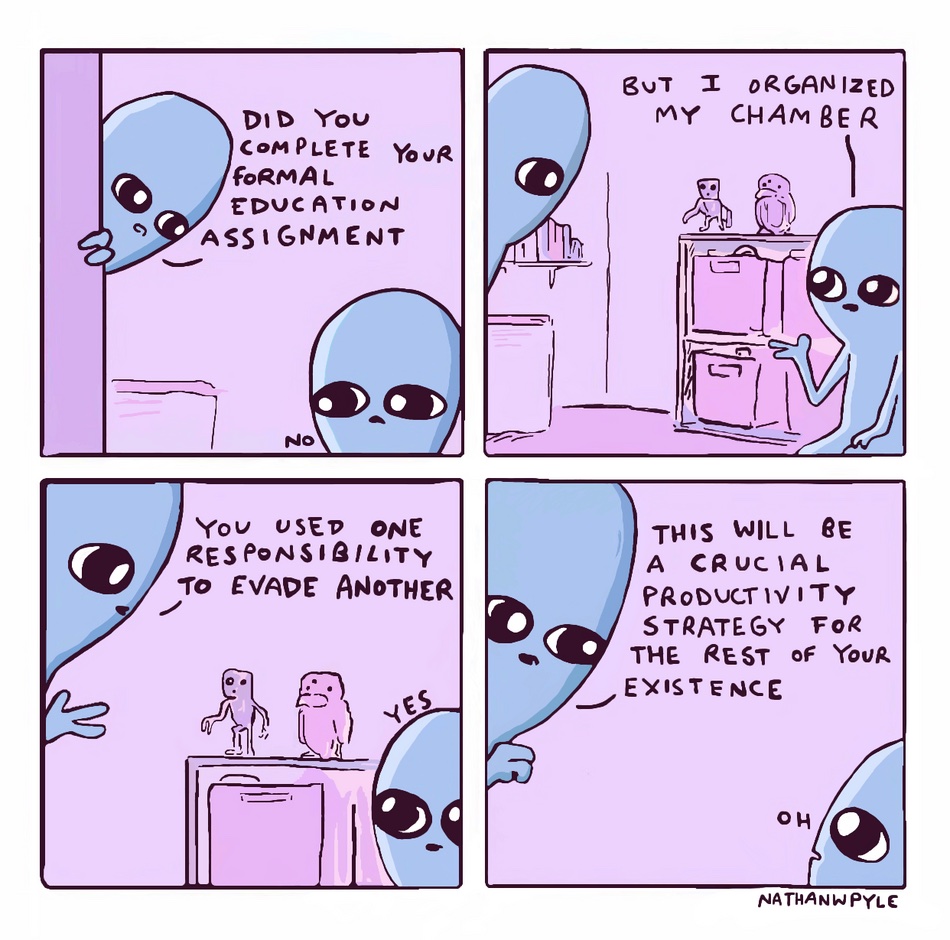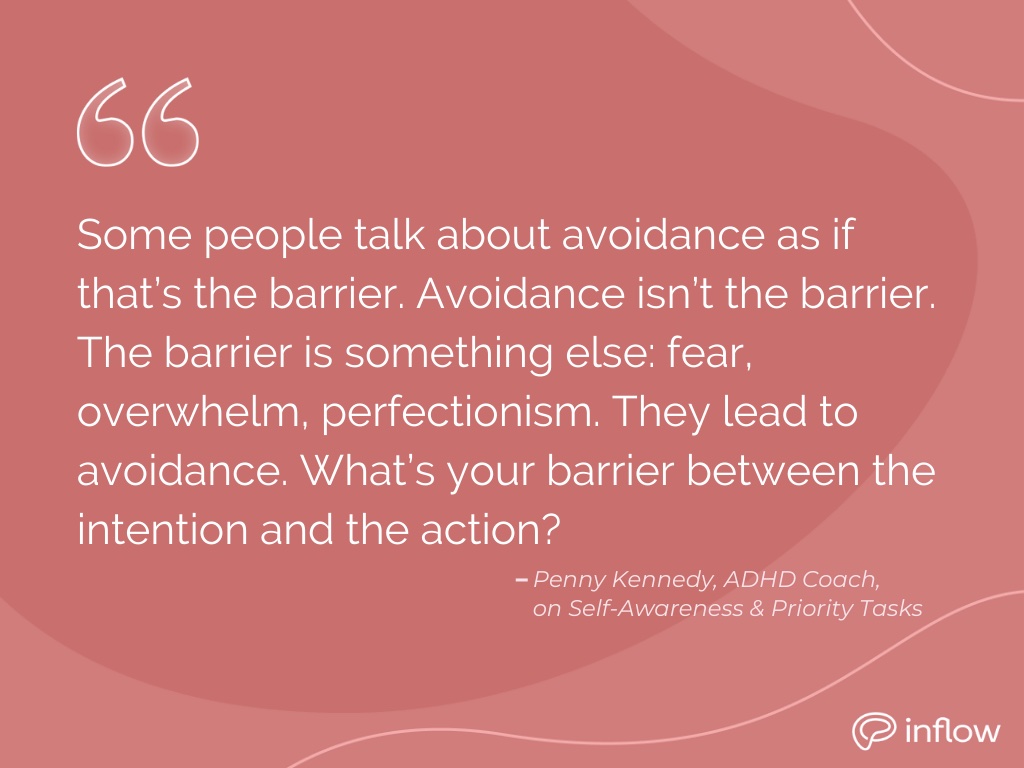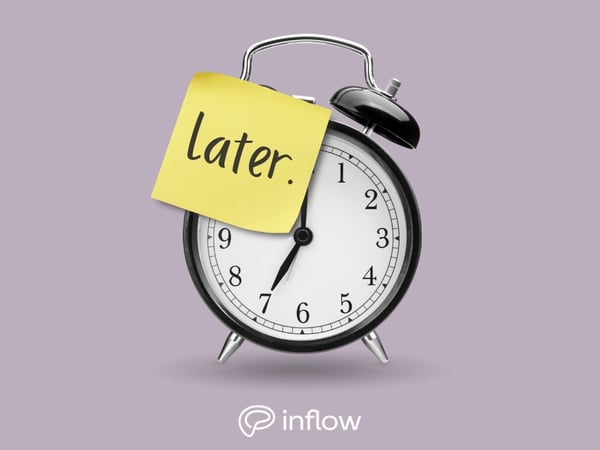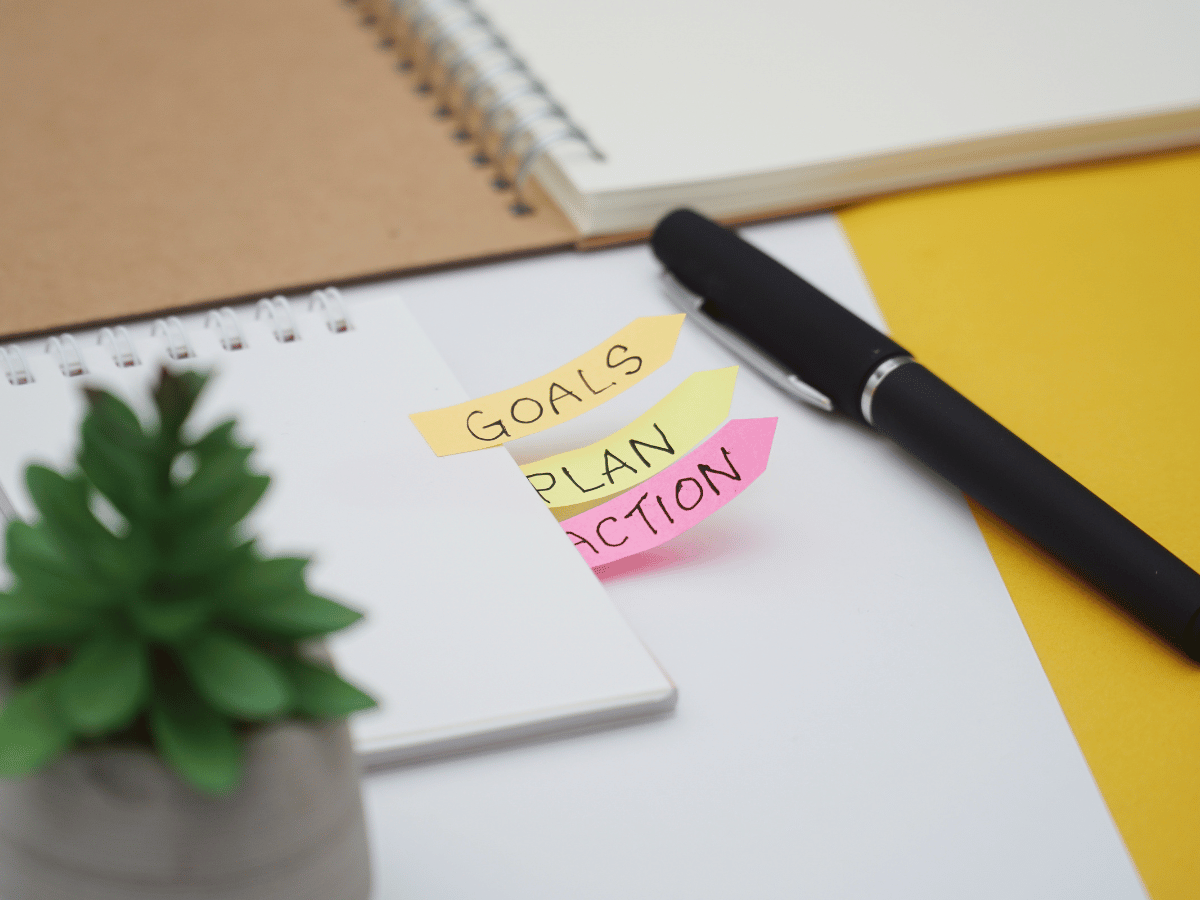Have you ever sunk into your chair at night, utterly exhausted, then realized you didn’t accomplish a single task from your to-do list?
The other day, I got up with the best intentions, a list of my important tasks at hand, only to end up washing dishes, popping in a load of laundry, and writing emails I’d been putting off. I even started trying out a new organizational tool for my dissertation notes instead of actually working on them. Before I knew it, the sun was setting and I hadn’t achieved any of the tasks I’d set out to do.
May I introduce you to “procrastivity”?
What is procrastivity?
Procrastivity is a wonderful portmanteau made up of “procrastination” and “activity”. It describes the act of procrastinating on high-priority tasks by doing other “busywork” instead. So, when you should be writing an essay, you might suddenly find it more attractive to do laundry. And doing your taxes is nowhere near as enticing as the prospect of gleaming windows and bathroom mirrors.
And don't even get me started on the state of the kitchen cabinet. That could really use a proper clear-out…

While I’m sure your future self will thank you for having clean underwear and your partner might be delighted with the shiny house, that essay doesn’t write itself and your taxes are still due. Procrastivity may make you feel productive and accomplished short-term, but ultimately, it’s a cunning version of task avoidance or “sneaky avoidance”.
Reasons for task avoidance
According to Penny Kennedy, a certified ADHD coach in the UK, the reasons for task avoidance and procrastivity are manyfold. Chief among them is the executive dysfunction many ADHDers experience. Executive Functions (EF) are a range of cognitive skills mediated by dopamine1, the neurotransmitter that’s likely deficient in ADHD brains. Some of these skills include:
- Working memory
- Organizing our thoughts
- Time management
- Attention regulation
- Activation of and switching between tasks
In addition to these neurological factors, perfectionism, negative self-talk, anxiety, feelings of overwhelm, and/or a fear of failure also play a role in avoidance behavior. In cases of late diagnoses, many ADHD adults have collected so many experiences of perceived failure and inadequacy that they’ve formed negative emotions associated with challenging tasks that require unassailable executive functioning skills.
Avoidance is often a learned coping mechanism to evade the stress connected to these feelings.
Why are we attracted to procrastivity tasks?
I’m sure everyone can imagine that scrolling through social media or playing video games would be preferable to doing taxes, but why do we often end up choosing to do chores like dishes, laundry, or yard work? Surely they aren’t attractive tasks in their own right. What is it that draws us to those specific tasks over high-priority ones? Procrastivity tasks tend to have shared characteristics:
1. They’re more ‘hands-on’ or less challenging than priority tasks
Trimming the hedges is less mentally-taxing than doing taxes; writing an email tends to be easier than writing a research paper.
2. They have a familiar launch sequence
There are specific well-known steps to initiate procrastivity tasks such as “put laundry into basket”, “bring basket to washing machine”, etc. This makes them easier to complete than the challenging priority tasks, when we’re often unsure where to begin.
3. They offer a better sense of progress
For example, when mowing the lawn, you have a clear visual of how much work you’ve done and how much is left. So, an activity like mowing or cleaning the mirrors isn't just easy to gauge, but seeing the end result of your efforts also provides a sense of satisfaction. Hello, dopamine!
With many priority tasks, measuring progress is more difficult as they often require more steps and several work sessions.
4. They’re "bounded tasks"
Procrastivity tasks tend to have clearly-defined ends: points where we can finally tick them off our to-do list, providing us with a sense of accomplishment.
If you’ve ever “finished” writing a paper, only to spend the next 6 hours questioning your sentence structure, proofreading, and reviewing footnotes (*Perfectionism has entered the chat!*), you’ll know that priority tasks often make it much more difficult to define an endpoint.
How to avoid task avoidance
Now that we know what makes us procrastinate by choosing busywork over priority tasks, we can use that knowledge to make them more palatable. Here’s a collection of tactics to help turn your intentions into actions and stay on task.
As always, ADHD manifestations differ from person to person, so mileage may vary. It’s a good idea to give yourself enough time to experiment with these strategies, see what works and what doesn’t, and if necessary: adapt.
1. Know your why
This is just another way of saying "know your reason(s)". With regard to priority tasks, there are two important why’s to consider: why you're doing it and why it's important.
Kennedy says that everything starts with self-awareness. It’s vital to understand the reasons behind your struggles with starting and completing priority tasks.

Equally crucial is knowing why your priority task is important to you. Align the task with your goals or values. Maybe finishing that essay gets you one step closer to your dream career; or studying for a dreaded exam will result in knowledge you can use to help others later on.
And in the case of taxes... at the very least, doing them on time will help you to avoid late fees. And who wants to create “ADHD tax” inception, really?
2. Create your own launch sequence
Start with the smallest actionable step. If you work away from home, that could be something physical, like getting to a library or logging on for a co-working session on the Inflow app.

3. Break. It. Down. (and be specific)
To make your progress measurable, it’s helpful to break tasks into small steps (and they’re probably smaller than you think).
Since priority tasks usually require multiple work sessions, it’s easy to lose sight of your efforts. Make sure you can see your progress on your priority tasks. There are two ways of doing this:
Time-bounding
Plan a specific start and end time for your work session. Instead of “working on taxes all morning”, make an appointment with yourself (e.g. Friday 10-10:45 AM).
It’s best to plan a reasonable, achievable time frame. If you end up working longer, that’s fantastic! But by defining an endpoint, you’re increasing the chances of actually getting started. Even very short times (e.g. 5 minutes) can help “trick” your ADHD brain into starting.
Task-bounding
Make specific intentions for the task you set out to do in a given work session. Instead of tasking yourself to “read literature”, try framing it as “read and annotate one academic paper”. Instead of saying “sort finances” define your task as “file 5 invoices”.
4. Schedule frequent breaks
Set a timer during scheduled breaks and do something stimulating (but not stimulating enough to hyperfocus on).
Examples: Move your body, call a friend, play a game or scroll through social media for 10 minutes. Drink some water while you’re at it.
5. Increase your dopamine
There are plenty of ways to increase dopamine, but for the purposes of this article, I'll list my favorite things that help to increase my dopamine levels:
Move
Any movement or exercise that increases your heart rate before starting the task.
Listen to music
Put on some of your favorite jams before and/or during your task. It boosts both dopamine and serotonin levels!
Reward yourself
Consider a reward to have waiting for you once you complete a work session.
Acknowledge and celebrate your little wins
Similarly, the simple act of recognizing your small successes; even if it’s just pausing to tell yourself 'good job!' for making a start. It still helps!
Bring along your favorite drink or snack
What food or drink makes your happy? Great! Now, bring them with you when you're about to tackle a task. This pairs perfectly with the mini breaks you've scheduled into your work sessions.
Decide if medication is right for you
The decision to take ADHD medication isn’t only a highly individual one, but it also hinges on accessibility (in terms of diagnosis and affordability) and health conditions that may prevent the use of ADHD medications.
Personally, I’m incredibly grateful to have this as an option, as it’s helped me tremendously in the short time I’ve taken medication.
Avoid boredom by incorporating novelty
ADHD brains love new things. Use this to your advantage! One way you can keep work sessions fresh is by letting 'the randomness' decide what to start with. Write a very specific list of your priority to-do’s and throw the dice, flip a coin, etc.
Be kind to yourself. Seriously.
Whatever strategies you try, remember to be kind and patient with yourself. Everyone has good and bad days, and not every strategy will work for every person or task. Some days it may be perfectly reasonable to delay a priority task to do chores. Other days, you may just need a rest, and that’s an important task in itself.








